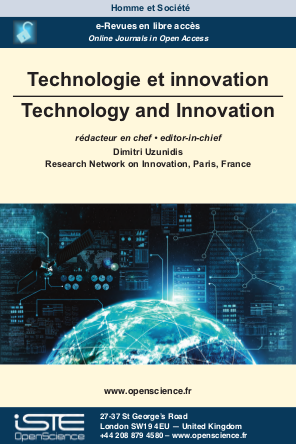

Social Sciences and Humanities > Home > Technology and Innovation > Issue
The journal Technologie et Innovation had published a second issue dedicated to the representations of technology in audiovisual fictions. Science fiction films therefore captured the interest of most of the researchers who participated. The articles question in particular the impact of often dystopian fictions on the creation of a technophobic climate potentially harmful to innovation. Virtual reality, “total memory” technologies, connected homes, artificial intelligence, medical technologies, neurotechnologies and video games are thus the subject of futuristic fictions warning the viewer about the negative uses of these machines. Faced with the thesis of a performative science fiction, science fiction is therefore conceived as an obstacle to innovation. The sum of this research directs us towards a conception of these stories as a cathartic imaginary, capable of considering the worst to purge the innovation process of negative passions, thus freeing capitalism and R&D to generate products that are sources of progress to humanity.
Since the 1980s, home automation and the digital home have been announced as the new era, ideal for the rest of housewives, and safe for families. However, if many university and industrial research laboratories are working hard on it, the market does not seem to take off in reality. This brake on success turns out to be partially, at least, linked to the collective imagination of the house of the future: many fictional elements concerning it deal with a form of black utopia, unconsciously charging the mind with a certain fear of what might happen. This article aims to highlight the difficult but inevitable relationship between works of science fiction and research on the house of the future.
This paper presents a classification of the various types of "total memory" technologies that have been imagined in a corpus of audiovisual science fiction between 1990 and 2022. These technologies, which often use the metaphor of memory as a database or plan, are depicted as allowing for the digitization and storage of human memories, as well as the retrieval and even modification of these memories and the identities of individuals. Through this analysis, this paper aims to explore such technological innovations for the enhancement or alteration of human mnemonic abilities.
Through a prospective reading of a science fiction movies selection, the author examines the evolution of the relationship that our so-called modern societies have with the human body — between research and phantasms, contemporary ethics and new ontology, contemporary expectations and future challenges. The films on which the author relies are Gattaca (1997, directed by Andrew Niccol), Blade Runner (1982, by Ridley Scott), Morgan (2016, Luke Scott), Repo Men (2010, Miguel Sapochnik), Terminator: Dark Fate (2019, Tim Miller), Selfless (2015, Tarsem Singh) and Chappie (2015, Neill Blomkamp). He thus tackles three key subjects such as they are dealt with in the speculative futures of these films, but which have their roots in our present: the genetic revolution and the risks of eugenics, the biomechanical revolution and the commercial temptation and, finally, a human ontology disrupted by the emergence of new alterities. In conclusion, the author offers an interpretation of the evolution of these relationships to the body, which he calls ―From sacred body to merchandised body‖.
If technology is a major theme in science fiction (SF), its treatment in movies is heterogeneous. Based on a comparative analysis of three artworks of science fiction, Star Trek, The Matrix and Black Mirror, the article proposes to build a continuum of analysis about the place and role of technology in works of science-fiction. At one end of the continuum, technology is a background that is not the subject of debate, but which, eventually, is a framework that facilitates a debate on a societal issue. At another extreme, technology is threatening and consubstantially opens the door to post-humanism. Between the two extremes, SF provides a critique of the perverse and cynical uses that our societies make of new technologies.
This article analyzes the representations of future video games from three science fiction films, Free Guy, Ultimate Game and Striking Viper (Black Mirror series). If the first is a new example of representation of an artificial intelligence revolt, the other two show applications of neurotechnologies. The latter are the subject of research by companies like Neuralink and could be the foundation of post-metaverse communication networks. Telepathy and neuroconnection are technotypes addressed by science fiction and which could generate sectoral myths in the future by revolutionizing the video geme industry. These science fiction films constitute an imaginary serving as a basis for an ethical and prospective reflection guiding research and development in computer science and virtual reality. The Frankenstein complex suggests that these fictions could be limits to innovation. They are also sources of inspiration for capitalsm constantly seeking new marketable technologies. By arousing a phenomenon of catharsis, this technomorphic imaginary makes it possible to purge the process of innovation of its negative passions and to direct it towards the progress of humanity.

2024
Volume 24- 9
Issue 12023
Volume 23- 8
Issue 12022
Volume 22- 7
Issue 12021
Volume 21- 6
Issue 12020
Volume 20- 5
Issue 12019
Volume 19- 4
L’innovation agile2018
Volume 18- 3
Issue 12017
Volume 17- 2
Issue 12016
Volume 16- 1
Issue 1